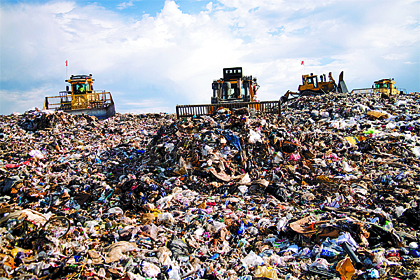By Patrick Pirtle
Contributing Writer
Every day, King County residents put materials in their trash, but have little knowledge of what happens to it after it leaves the curb. Americans have become detached from the realities of their growing trash problem. King County’s population has grown by 5.8 percent from 1999 to 2005. At the same time, the amount of trash we produce has increased even more, to about 4.3 pounds a day per person on average.
Each week, trash is taken from Snoqualmie and brought to the Cedar Hills Regional Landfill, located in Maple Valley, 29 miles away. About one million tons of garbage goes to Cedar Hills each year. When trash arrives, it is buried and placed in layers inside lined pits, called cells. Each day, the layers of garbage are covered with soil. Once a cell is full, soil is placed over it to mitigate erosion. Once these sites close, it is necessary for long term monitoring to make sure that pollution is staying on the site. At King County’s current rate of waste production, our regional landfill will reach capacity within the next decade.
Once Cedar Hills reaches capacity, King County will export its waste outside, like Seattle, which sends its trash by train every day to an Oregon landfill. Exporting garbage puts more stress on the environment from increased carbon emissions and use of fossil fuels needed to move our waste an even-greater distance, bringing increased costs that trickle down to the user, causing garbage prices to increase.
We can prolong the life of the Cedar Hills landfill through recycling more and reducing our consumption habits.
This year, King County built the “Cube of Food,” which was on display at Railroad Days to show residents the currently low trend of recycling food scraps — and how easy it can be to start recycling leftover food.
The average family in King County throws away nine pounds of food a week, or 477 pounds a year; 26 percent of what enters the Cedar Hills landfill is food scraps and compostable paper. More than half of what enters the landfill could have been recycled.
Right now, nearly all King County single family garbage customers can recycle all food scraps and food-soiled paper in their yard waste carts. The organic waste goes to Cedar Grove, a composting facility, where it is turned into high grade compost, and sold at local hardware and garden stores for use in gardens. Since 1989, Cedar Grove has diverted more than four million tons of organic material from landfills.
With King County’s current garbage and recycling program, residents can reduce the amount of garbage that they put into the landfill by recycling and composting. This can also lead to savings in your pocket book. With less trash, residents can reduce the size of their garbage can and thus reduce the monthly expense. In Snoqualmie, it is 15 percent cheaper to have a combination of a small garbage can and yard waste bin than the standard garbage can alone.
Learn more by visiting www.kingcounty.gov/solidwaste or www.cedar-grove.com
• Patrick Pirtle is a University of Washington student and Snoqualmie Recycling Program Intern.


